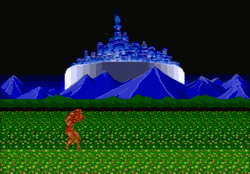 Never thought I’d say this about a 16-bit console game, but here we are: the best levels in Toki: Going Ape Spit are the water and ice levels. And the mine cart stage isn’t bad, either!
Never thought I’d say this about a 16-bit console game, but here we are: the best levels in Toki: Going Ape Spit are the water and ice levels. And the mine cart stage isn’t bad, either!
Toki: Going Ape Spit is basically the “HD Rerelease” of the arcade game Toki that was also ported to every system available back in the 80’s. Despite being an upgraded version, if you’ve played Toki in the arcades, this is basically the same gameplay. Remember Contra? Remember how fun it was to run and shoot enemies on your way to monstrous bosses and diverse, exciting environments? Well, this is basically the same, except minus that whole “running” thing. Toki (a Tarzan looking Adonis that is transformed into an ugly monkey by a jealous wizard) is able to shoot an unlimited number of energy bullets from his mouth, but moves about as fast as a snail on dial-up. This is completely deliberate, though, as the majority of traps and monsters work as obstacles that are there to tell you to slow down there, chimpy, no need to rush. A common “enemy” is a spike covered with spikes (“yo, dawg…”) that erupts from the ground when Toki gets close. If you’re moving slowly, it’s an inanimate object that can be simply shot into oblivion (and be sure to duck to avoid shrapnel), but if you’re trying to barrel forward at maximum-Mario speed, you’ll be instantly skewered to monkey heaven. You’ll likely learn this lesson within the first level, and from then on, you know you’re in for a slow experience.
And, to be clear, this by no means makes Toki: Going Ape Spit a bad game, it’s just very… measured. Toki dies after a hit, and there’s no such thing as checkpoints, so while you’re just as fragile as Bill Rizer, your respawns are nowhere near as generous. Assuming you’re not a fan of playing the same areas over and over again, you’ll learn very quickly to embrace the slow approach, and protect your monkey at all costs. The arcade version of Toki would grant a powerup that allowed you to take a hit, but that’s completely missing from the Genesis, and, coupled with the “speed up” powerup existing in something like only three stages out of a possible 27, it’s as if the designers behind the “remixed” Toki want you to take it slowly at all times. And you will, oh yes, you will.
Except in a couple of spots…
Level Three is the “water world” of the game (probably not coincidentally just like in Super Mario Bros. 3), and Toki will be submerged for the entirety of the experience. 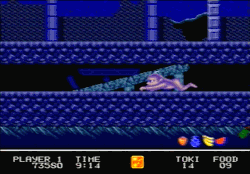 Luckily, Toki is a lot more buoyant than some hedgehogs, and Mr. Monkey has complete swimming mobility underwater. It’s not even “hammer the A button forever” swimming, either, this is full-control, “frog suit” freestyle. Couple this with Toki’s fireball-spewing mouth, and you’ve got an honest to God shoot ‘em up stage (without any messy auto scrolling) in the midst of the slowest platformer this side of the Atari. It’s a fun change of pace in a game that absolutely needed a break from its usual tempo.
Luckily, Toki is a lot more buoyant than some hedgehogs, and Mr. Monkey has complete swimming mobility underwater. It’s not even “hammer the A button forever” swimming, either, this is full-control, “frog suit” freestyle. Couple this with Toki’s fireball-spewing mouth, and you’ve got an honest to God shoot ‘em up stage (without any messy auto scrolling) in the midst of the slowest platformer this side of the Atari. It’s a fun change of pace in a game that absolutely needed a break from its usual tempo.
And it’s kind of amazing, because the “underwater level” in a 2-D game is usually the worst experience you can find. Has anyone ever enjoyed attempting to maneuver around an erratic blooper, or, worse, an ocean full of motionless but deadly electric jellyfish? Or maybe underwater platforming is more your speed, and you always use that level select trick to skip straight ahead to Labyrinth Zone. Do you know anyone like that? And did that person eventually turn out to be a serial killer? If it hasn’t happened yet, head’s up, you’ll soon see that Festivus collection of Ginsu knives referred to as “Exhibit A”.
Then, after a few more levels (and a battle against a boss known only as “The Belcher”), Level Six presents the “ice world”. Happy ice stage, everybody, it’s time to slip around on slick floors and turn the idea of carefully calculated 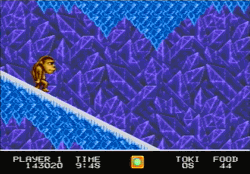 walking into a constant slide into a waiting enemy or gaping pit. But, again, Toki somehow makes the experience cool! Rather than simply making the frozen wonderland a platforming hell, Toki opts to create interesting “puzzles” using the increased momentum available when skating on ice. And the designers, for the first time all game, actually encourage speed by foregoing the “gotcha” enemies and providing shortcuts and collectibles that are only available if you can hustle time-limited powerups from one end of the stage to the other. For exactly one level, you’ve gotta go fast, and it’s thrilling because it’s such a deviation from the rest of the game.
walking into a constant slide into a waiting enemy or gaping pit. But, again, Toki somehow makes the experience cool! Rather than simply making the frozen wonderland a platforming hell, Toki opts to create interesting “puzzles” using the increased momentum available when skating on ice. And the designers, for the first time all game, actually encourage speed by foregoing the “gotcha” enemies and providing shortcuts and collectibles that are only available if you can hustle time-limited powerups from one end of the stage to the other. For exactly one level, you’ve gotta go fast, and it’s thrilling because it’s such a deviation from the rest of the game.
And, finally, there’s the minecart experience, quarantined exclusively to stage 9-2 (9-3 is the final stage, incidentally). Toki does something so… brilliant with the minecart concept that I’m amazed that, 25 years later, we haven’t seen the concept revisited and perfected. The minecart stage is a vertical shaft with minecarts “zigzagging” across the length of the stage, so you go left on one minecart, make a little vertical headway on a platform at the end of your trip, and then ride another cart back to the right, repeat until you’re at the apex of the level. The interesting bit is that there are never any obstacles on the trip left, but you get a preview of the dangers you will experience on the return trip right. This means that, even though the minecarts move at typical rollercoaster speed, 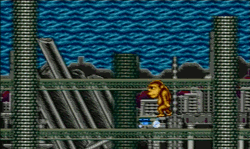 you always know what’s coming, so it’s not a matter of jump jump slide with perfect reaction time, no, now you actually have a chance because you’re allowed the tiniest bit of foresight while safe. It’s a subtle change to the formula that makes all the difference to a platforming staple that apparently missed this luminous innovation two decades back. Everybody was watching the wrong monkey!
you always know what’s coming, so it’s not a matter of jump jump slide with perfect reaction time, no, now you actually have a chance because you’re allowed the tiniest bit of foresight while safe. It’s a subtle change to the formula that makes all the difference to a platforming staple that apparently missed this luminous innovation two decades back. Everybody was watching the wrong monkey!
So, good job, Toki: Going Ape Spit, for making what could be another forgettable Sega Genesis arcade port an interesting, fun experience. Toki might be largely forgotten by later games of the genre, but it’s well worth a play if you’re in the mood for some good ol’ saunter ‘n gun gaming.
FGC #81 Toki: Going Ape Spit
- System: Sega Genesis, though you can find “lesser” versions of the game at the arcade, or on the NES, Atari Lynx, or Commodore 64. Apparently there’s an iphone version, too? I can’t speak to the port differences, as I don’t want to ruin the high of the pleasant surprise that is the Sega Genesis version.
- Number of players: 2 players alternating. Hey, looks like all the games this week are going to be 2-player. Neat!
- Favorite Powerup: Toki has a variety of options available for all his magic spewing needs, including “spread” and “flamethrower” options that I’m pretty sure were used during the Red Falcon Conflict, but my favorite is a special ability that allows Toki to hurl colossal bouncing balls of destruction and absolutely fill the screen with monkey-flung death. Considering you can usually only have a limited number of projectiles on the screen at a time, it’s astonishing that the bouncing ball power seems capable of practically overcrowding the area without any slowdown. It’s the little things that impress me about Toki.
- Favorite Boss: BEHOLD THE BELCHER!
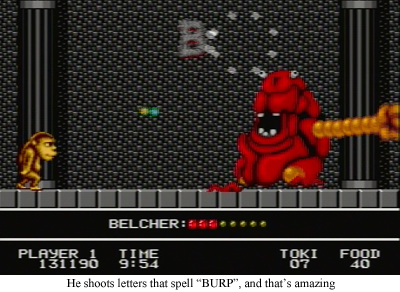
- Difficulty: Can’t emphasize this enough: move slowly! If you take your time and wait for the enemies to spawn while you still have some distance to maneuver, you should have no problem regaining Toki’s original Skarsgård form. Beyond that, you’ll still probably die more than a few times, but if you set the game to reward Toki with an extra life every 7,000 points, you should still be rolling in 1-ups by the time you face Stark. Speaking of which…
- A Wily Opponent: Stark, the evil wizard that cursed Toki and kidnapped his girlfriend, eventually is fought as the final boss (and… second to final boss). His attack pattern consists of randomly warping around the screen, producing a series of projectiles that home-in on Toki, and then disappearing to repeat the process all over again. I guess this is federally mandated evil genius final boss behavior in some countries.
- Toki Toki Panic: Oddly, the plot of this game (evil force mysteriously appears, transforms man into monkey, and then kidnaps girlfriend) was repeated almost exactly for Congo’s Caper, another 16-bit platforming/action game. Congo only has a club to rely on, and his venue is more “prehistoric” than “random jungle”, but it’s a really bizarre coincidence.
- Did you know? There seems to be more than a passing resemblance between Toki’s (lauded) World Three and the Shantae: Risky’s Revenge final underwater gauntlet. Aside from them both being underwater excuses to turn the game into a shooter, they both feature “Atlantis”-like backgrounds and persistent, disposable enemy mooks that attack while equipped with breathing apparatus, and then unceremoniously drown when defeated by the protagonist. Wonder if there was some inspiration there…
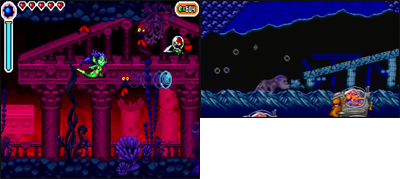
- Would I play again: Probably not, really. I’d like to see some of Toki’s innovations influence 2-D platforming/action games of the future, but the actual game itself is very slow, and, for all the effort it takes to make it through the thing, I could be playing Super Mario World. I’d recommend playing through Toki: Going Ape Spit at least once in your life, but revisiting it isn’t all that necessary.
What’s Next? Random ROB has chosen… Tekken 4 for the Playstation 2. Fair warning, there’s one thing I remember that game for, and it’s more the “Playstation 2” part than the actual game. Get ready for one of the greatest unexplained phenomena of our age. Please look forward to it!

[…] video games for a number of different reasons. Within the last sixty or so posts, I’ve looked at a game where Tarzan gets turned into a fire-breathing monkey to battle a techno witch doctor, another where a magical guitar from space is able to repel Elvis the Bee, and whatever the hell […]
[…] level: Once again, I’m impressed by how much fun an underwater stage can be on Sega hardware. Did underwater stages […]